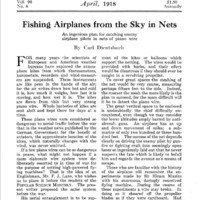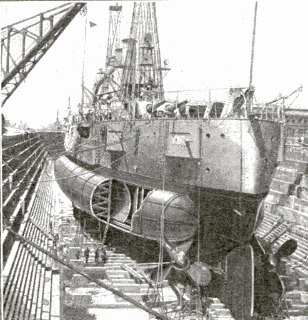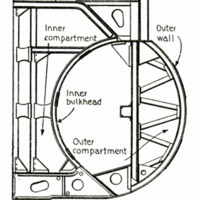Torpedo-proofing ships with air tanks
Item
-
Title (Dublin Core)
-
Torpedo-proofing ships with air tanks
-
Article Title and/or Image Caption (Dublin Core)
-
Torpedo-Proofing Ships with Air Tanks. Air-cushions to run along sides of ship are proposed as a protection against torpedoes
-
Caption 1: A cruiser in dry-dock, showing how the airchambers are attached below the waterline
-
Caption 2: Diagrammatic view of the latest torpedo protection
-
extracted text (Extract Text)
-
SINCE the beginning of the Great
War, and particularly since Germany
“adopted the submarine policy, the
brains and inge-
nuity of inventors
of all classes and
ratings have been
directed toward
finding some means
of counteracting
the destructive ef-
fects of the torpedo.
Many expedients
have been sug-
gested, ranging all
the way from ex-
tremely feasible
propositions to the
wildest vaporings.
The following arti-
cle deals with one
of the more prob-
able ones.
Hudson Maxim,
who has, hime:If,
suggested a method
for torpedo-proofing ships in which he
makes use of the principle of the “gun
silencer,” states that the explosive charge
in the war-head of a modern torpedo con-
sists of about four cubic feet of T.N.T.
(tri-nitro-toluol). When the detonator
inside the charge is fired
the T.N.T. explodes, and
within less than the
twenty-thousandth part
of a second the four cubic
feet of explosive are trans-
formed into 40,000 cubic
feet of gases, having a
temperature of about
5,000 degrees F. The
mass of water surround-
ing the explosive offers a
greater resistance to the
sudden expansion of the
gases than the wall of the
ship and as the expansion
follows the line of least
resistance, the wall of the
ship is crushed and the
expanding gases enter into the body of the
ship with destructive violence. |
With this picture of a torpedo’s effect
before us we are
prepared to under-
stand the invention
of Thomas G. O.
Thurston, of Lon-
don, England, re-
cently patented in
the United States.
Thurston, taking
the terrific expan-
sion of the gases
generated by mod-
ern explosives into
account, seeks to
provide a system of
large resistance and
expansion cham-
bers which act like
an air-cushion by
which the force of
the inrushing gases
is smothered and
robbed, to a great
extent, of its destructive potentiality.
The inventor proposes to construct
these shock-absorbing chambers along the
sides of the ship for a suitable distance °
forward and aft. He suggests various
forms, all showing a decided bulging out-
ward, beyond the normal
contour of the ship. The
back of these bulging
outer chambers, formed
by a suitably stiffened
bulkhead or inner frame-
work, separates the outer
chamber from the inner
compartment, which pro-
vides the final and strong-
est resistance to the ex-
panding gases. This in-
ner compartment has a
strongly braced back,
curving inward toward
the interior of the ship,
and the air contained in
it is intended to act as an
additional cushion.
-
Contributor (Dublin Core)
-
Thomas G. O. Thurston (inventor)
-
Language (Dublin Core)
-
eng
-
Date Issued (Dublin Core)
-
1918-04
-
pages (Bibliographic Ontology)
-
587
-
Rights (Dublin Core)
-
Public Domain (Google digitized)
-
Archived by (Dublin Core)
-
Filippo Valle
-
Alberto Bordignon (Supervisor)
 Popular Science Monthly, v. 92, n. 4, 1918
Popular Science Monthly, v. 92, n. 4, 1918





